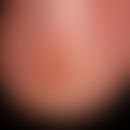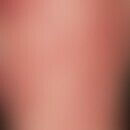Synonym(s)
DefinitionThis section has been translated automatically.
Autosomal-dominantly inherited form of isolated toe nail dystrophy occurring as a clinical feature in families in which another member had autosomal recessive epidermolysis bullosa (OMIM 226600) or transient bullous dermolysis of the newborn (OMIM 131705).
EtiopathogenesisThis section has been translated automatically.
This is caused by a heterozygous mutation of the COLA7A1 gene. The COLA7A1 gene is located on chromosome 3p21.31 and codes for the protein of the same name (collagen 7).
ClinicThis section has been translated automatically.
The nail changes in isolated toenail dystrophy are most severe on the big toes. Here the nail plate is buried in the nail bed with a deformed and narrow free edge. This form of toenail dystrophy is called "Non-syndromal congenital nail disease 8, also known as NDNC8".
Sato-Matsumura et al (2002) examined 2 unrelated Japanese families with autosomal recessive inherited dystrophic epidermolysis bullosa (RDEB) for mutations in the COL7A1 gene and identified family members with dystrophic changes that were restricted to the toenails but showed no other signs of epidermolysis. The isolated toenail dystrophy was inherited autosomal-dominantly. The patients with RDEB in each family were heterozygous for 1 of these mutations in combination with a nonsense or frameshift mutation in COL7A1. These results support the notion that certain mutations in the collagen domain of COL7A1 cause limited nail deformity and that these alleles, in combination with nonsense or frameshift mutations in the COL7A1 gene, may lead to varying degrees of epidermolytic skin changes.
Hammami-Hauasli et al (1998) reported a family of a 14-month-old girl with transient bullous dermolysis of the newborn (TBDN; OMIM 131705). A mutation in the COL7A1 gene was detected. The corresponding mother, proved to be a heterozygous carrier of the G2251E mutation. She had a toenail dystrophy, but no skin lesions. The maternal great-grandmother was reported to have had dystrophy of some fingernails since childhood, but never showed signs of epidermolysis bullosa. The father, who had the G1519D mutation, was not clinically affected.
LiteratureThis section has been translated automatically.
- Hammami-Hauasli N et al (1998) Transient bullous dermolysis of the newborn associated with compound heterozygosity for recessive and dominant COL7A1 mutations. J Invest Derm 111: 1214-1219.
- Hatta N et al (1995) Spontaneous disappearance of intraepidermal type VII collagen in a patient with dystrophic epidermolysis bullosa. Brit J Derm 133: 619-624
- Sato-Matsumura K C et al (2002) Toenail dystrophy with COL7A1 glycine substitution mutations segregates as an autosomal dominant trait in 2 families with dystrophic epidermolysis bullosa. Arch Derm 138: 269-271
Incoming links (2)
Dystrophic epidermolysis bullosa ; Genetically caused non-syndromal nail abnormalities;Outgoing links (2)
Epidermolysis bullosa hereditaria (overview); Transient bullous dermolysis of the newborn;Disclaimer
Please ask your physician for a reliable diagnosis. This website is only meant as a reference.



